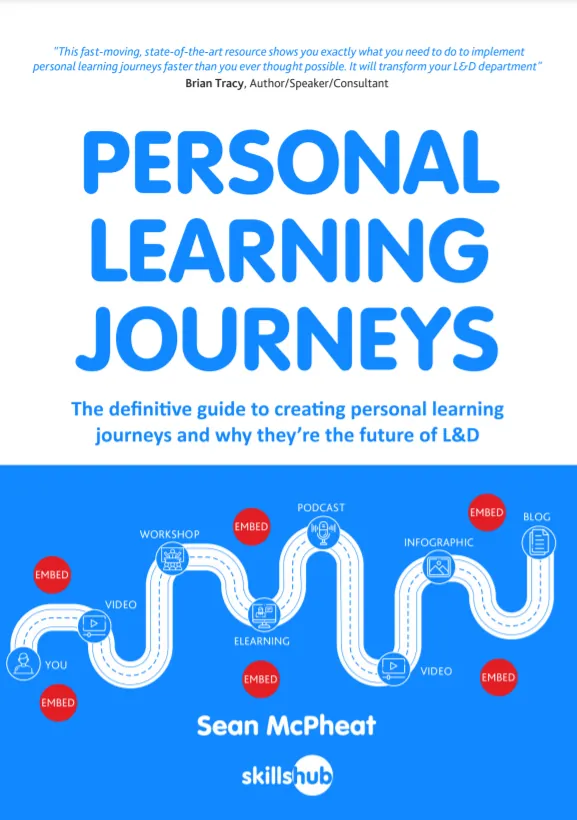
Even if you don’t work in the education sector, you’ve likely heard the word “pedagogy.” The term “andragogy” is a little less familiar to most, though.
In this guide, you’ll learn the difference between pedagogy and andragogy and discover the various ways that an elearning company, like Skillshub, can help you apply the principles of these learning strategies in your employee training and coaching processes.

What is Pedagogy and Andragogy?
Put simply, “pedagogy” refers to the practice of teaching children. It is derived from two Greek words: “Paidi,” meaning “child,” and “ago,” meaning “guide.”
Androgogy, on the other hand, refers to the practice of teaching adults. It is also derived from two Greek words: “Andras” or “man” and “ago.”
The differences between pedagogy and andragogy extend beyond their Greek roots. The principles of both learning strategies are explained in the following sections:
Principles of Pedagogy
When they first start looking for answers to questions like “What is pedagogy?”, most people come across a list of principles that distinguish it from andragogy and other modalities. Here are the fundamental principles of pedagogy:
- Constructivist: Constructivist pedagogy advocates for a “reversed classroom” approach in which students facilitate their own learning by building off previous knowledge or experiences. Teachers act as guides to help students understand processes and applications.
- Collaborative: Collaborative pedagogy allows learners to work in pairs or groups to understand concepts and apply them to real-life situations.
- Inquiry-based: Inquiry-based pedagogy focuses on situations and problems students will experience in their line of work. It can be case-study-based or address specific challenges or issues that students have previously experienced.
- Integrative: Integrative pedagogy allows students to learn while interacting with others and discussing specific topics designed to stretch their minds, challenge assumptions, and practically apply what they’ve previously learned.
- Reflective: Reflective pedagogy, as the name suggests, gives learners a chance to reflect on the information they’ve collected so far and identify what they understand, what they need to study further, etc.

Learn How To Create Personal Learning Journeys For FREE!
Principles of Andragogy
Like pedagogy, andragogy is also characterised by certain principles and practices, including the following:
- Why and How: Adults must understand the “why” or reason behind what they’re learning and how it applies to their lives.
- Experience: Adults must apply previous experience to new learning environments and understand how their past affects and informs their current identity and abilities.
- Self-concept: Adults are typically more self-aware and autonomous than children and, as such, learn better independently instead of being heavily micromanaged by an instructor.
- Readiness: Adults require flexible, approachable, and applicable learning materials that fit readily into their daily lives and schedules.
- Problem Orientation: Adult learning requires an emphasis on problems the learner is likely to face and potential practical solutions.
- Intrinsic Motivation: Andragogy is most effective when it builds off adults’ inherent motivation to succeed and gain a sense of self-actualisation.
Knowles’ Adult Learning Theory
Malcolm Knowles, an adult educator and researcher, was one of the first experts to focus on the differences between how adults learn compared to children.
In the 1950s, Knowles started using “andragogy” to describe the way adult learners are motivated to gain new knowledge and insights. He also developed a theory based on these principles:
- Adults are self-directed and depend less on teacher instruction
- Adults reference past experiences when learning new information
- Adults’ motivation to learn relates to their social roles
- Adults prefer learning solutions that are applicable to real-life
- Adults rely on intrinsic motivation more than external rewards
Over time, other educators adopted Knowles’ theory. It still serves as the basis for the andragogy model that is used in adult education programs worldwide.

What are the Advantages and Disadvantages of Pedagogy vs. Andragogy?
Pedagogy and andragogy both come with unique advantages and disadvantages for learners and instructors. The following are some of the most noteworthy pros and cons of these two approaches:
Pedagogy Advantage: More Structure and Guidance
Because pedagogy centres around a more traditional learning approach — one in which knowledge is handed down from the teacher to the student – it is typically more structured. This structure can make it easier for the instructor to guide learners and ensure they meet specific milestones in a timely manner. It allows for a more organised learning environment, too.
Pedagogy Advantage: Easier to Assess Progress
The structured nature of a pedagogical approach lends itself to more straightforward learner assessment and progress tracking. Instructors that utilise a pedagogical approach tend to have clear rubrics and other monitoring methods they use to evaluate each student, understand their current level of mastery, and identify the specific areas in which they require more guidance, assistance, etc.
Pedagogy Advantage: Increased Efficiency
The structure associated with pedagogy, as well as the increased ease with which instructors can measure progress, can also make learning more efficient. This efficiency is particularly valuable when an instructor is leading a large classroom and wants to ensure as many people master a specific subject as possible.
Pedagogy Disadvantage: Less Autonomy
One of the downsides of pedagogy is that it provides students with less autonomy. While particular forms of pedagogy, such as collaborative and constructive pedagogy, can allow for more student involvement and empowerment, it’s still, generally, less autonomous than an andragogical approach, which can be frustrating for adults who are used to working at their own speed and in their own way.
Pedagogy Disadvantage: Potential for Irrelevancy
There’s more potential for irrelevancy in a pedagogical approach, too. Instructors who rely on pedagogical teaching methods may not adapt their lesson plans and curricula to different students’ needs and goals, causing the student to spend time and energy focusing on subjects and topics that aren’t relevant to their everyday life (this, in turn, can lead to a lack of interest and subpar performance).
Andragogy Advantage: More Control and Independence
The andragogical approach caters to learners who prefer working at their own speed and having more control over what, when, and how they learn. Adult learners, in particular, tend to gravitate toward these approaches because they fit better into their everyday lives and empower them to take their education into their own hands.
Andragogy Advantage: Focused on Experience
Andragogical learning methods give more credence to learners’ past experiences and personal insights. The ability to personalise their learning and bring in individual scenarios and situations can increase learner engagement and information retention, both of which allow for better learning outcomes.
Andragogy Advantage: Focused on Problem-Solving
With an andragogical approach, instructors can spend more time helping students develop their problem-solving skills, specifically when it comes to scenarios they are likely to face in their careers and everyday lives. As is the case with the focus on experience, this benefit can lead to better engagement rates and learning outcomes.
Andragogy Disadvantage: May Be Too Open-Ended
While many learners appreciate the open-endedness of andragogy, as well as the emphasis on independent learning, some require more structure and guidance. For those students, andragogy may give them too much freedom, which can interfere with their ability to retain information and apply it in their day-to-day lives.
Andragogy Disadvantage: Harder to Assess Progress
Because of its open-endedness, instructors who utilise an andragogical approach may find it harder to assess learners’ progress. This issue is especially likely if the instructors aren’t using transparent rubrics, regular exams and assessments, and other progress-monitoring tools.

When Should the Pedagogical vs. Andragogical Approach Be Used in Learning?
There’s no one-size-fits-all approach when it comes to developing a training program. In some situations, pedagogy is more appropriate, and in others, andragogy makes more sense.
For example, say you want to be able to measure progress efficiently and effectively. In that case, a more structured, pedagogical approach would be appropriate.
Conversely, if you want learners to feel more empowered and want to help them develop their problem-solving skills, you may take a more open-ended andragogical approach.
Blending Pedagogy and Andragogy
The good news is that you also don’t have to choose between pedagogy vs andragogy. You can blend the two approaches and utilise each option’s strengths to create a better learning environment for a more significant number of students.
The following are some examples of how you can blend pedagogy and andragogy:
Combine Synchronous and Asynchronous Learning
Synchronous learning involves students learning at the same time, either in person or virtually. Asynchronous learning, on the other hand, involves students learning at their own pace and according to their own schedule.
Synchronous learning, generally, aligns more with a pedagogical approach, whereas asynchronous learning fits better into an andragogical framework.
By conducting certain learning sessions synchronously and allowing students to learn certain subjects or work through specific modules asynchronously, you can cater to those who prefer more structure and those who like a more autonomous approach.
Looking to implement these versatile learning approaches effectively? Skillshub offers a range of virtual training solutions designed to enhance your training capabilities.
Incorporate Multiple Learning Styles
You can use a structured pedagogical approach and cater to a larger audience with your lesson plans by focusing on multiple learning styles when developing materials. For example, if you take things like information processing theory and Kolb’s learning styles into account, you can ensure various students, regardless of their unique learning preferences, can take in information in a way that makes the most sense for them.
Utilise Adaptive Learning
Adaptive learning uses artificial intelligence and other technologies to allow for a more personalised learning experience. Although it still offers some structure in how information is administered, it also provides a level of personalisation and self-pacing that makes it appropriate for and beneficial to learners who prefer a more andragogical approach.
Provide Ongoing Support to Learners
Some learners may find the andragogical methodology too open-ended. However, you can still help these learners succeed by making sure they receive ongoing support from you and have access to a variety of learning resources. The more support they receive, the easier it is for them to adapt to a more self-directed learning style and ensure they gain the information they need as efficiently as possible.
Seek and Respond to Feedback from Learners
Whether they’re partial to andragogy or pedagogy, instructors can improve their teaching style (and, therefore, improve learning outcomes) when they seek feedback regularly from students. When students have an opportunity to share what they like and dislike about an instructor’s approach, the instructor is then empowered to provide better information in the future and set students up to complete their courses successfully.
Final Thoughts
Both pedagogy and andragogy offer value when it comes to creating a supportive and effective learning environment. You can also combine elements of the two approaches by using other strategies like synchronous and asynchronous learning and adapting training to different team members’ needs and personal learning styles.
Are you seeking assistance in broadening your company’s training resources to incorporate the best elements of pedagogy, andragogy, and various other teaching and learning modalities?
If so, Skillshub provides an array of bespoke training tools, including an elearning platform, extensive e-learning content, virtual training, and custom elearning development. These resources are customisable to suit the specific needs, motivations, and goals of your employees, enhancing their learning experience.













